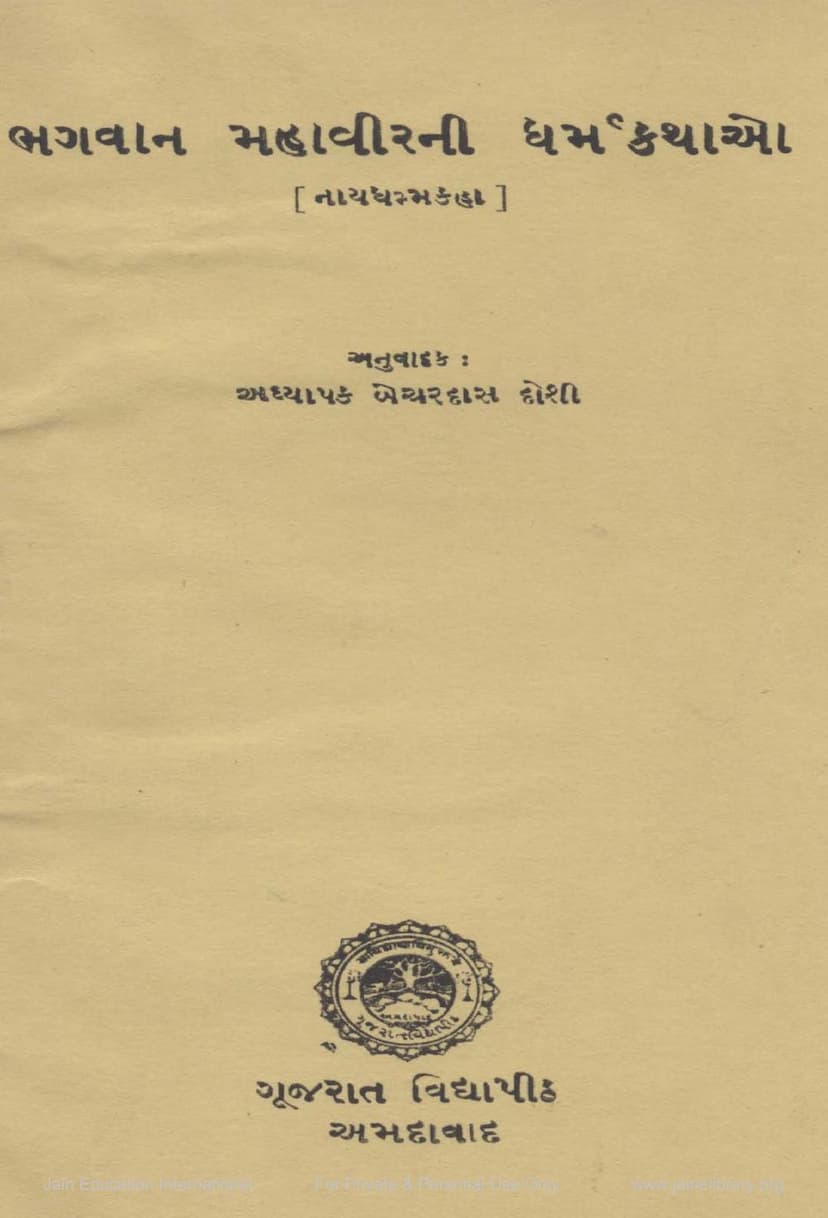Bhagwan Mahavira Ni Dharmkathao
Added to library: September 1, 2025

Summary
This is a comprehensive summary of the Jain text "Bhagwan Mahavira ni Dharmkathao" by Bechardas Doshi, published by Gujarat Vidyapith Ahmedabad. The book is the sixth Anga of the Jain Agamas, known as Nāyādhammakahāo (or Nāyādhammakahā).
The book is a collection of religious discourses (Dharmakathao) attributed to Bhagwan Mahavir. These narratives are presented as dialogues and stories designed to impart spiritual and ethical lessons.
Key aspects of the book and its content:
-
Structure and Content: The book is a Gujarati translation of the Nāyādhammakahāo, a significant Jain scripture. The original scripture is said to consist of two sections: one containing illustrative examples (Jñātodāharaṇa) and the other containing religious stories (Dharmakathāo). The translation aims to make these teachings accessible to a wider audience.
-
Purpose and Philosophy: The primary purpose of these stories is to guide individuals towards spiritual liberation. They emphasize the importance of righteousness, detachment, compassion, and ethical conduct in daily life. The narratives illustrate the consequences of actions (karma) and the path to overcoming worldly attachments.
-
Narrative Style: The stories often employ allegorical and illustrative methods, using everyday situations, natural phenomena, and human relationships to convey profound philosophical truths. This approach makes complex spiritual concepts relatable and memorable for the readers.
-
Themes and Lessons: The collection covers a wide range of ethical and spiritual themes, including:
- Righteousness and Conduct: The importance of adhering to Jain principles like non-violence (ahimsā), truthfulness (satya), non-stealing (asteya), chastity (brahmacharya), and non-possession (aparigraha).
- Detachment and Renunciation: The stories often highlight the transient nature of worldly pleasures and the ultimate liberation found in detachment from material possessions and sensual desires.
- Consequences of Actions (Karma): Many narratives illustrate the law of karma, showing how past actions lead to present circumstances and future outcomes.
- Compassion and Equality: The teachings promote universal love and compassion, advocating for equality among all living beings.
- Wisdom and Understanding: The stories emphasize the pursuit of knowledge and wisdom as crucial for spiritual progress.
- Cautionary Tales: Some narratives serve as warnings against vices like greed, anger, ego, and attachment, illustrating their destructive consequences.
-
Key Characters and Settings: The stories are set in various locations and feature a range of characters, including kings, queens, ministers, merchants, ascetics, ordinary citizens, and even animals, often interacting with Bhagwan Mahavir or his disciples.
-
Specific Story Examples (from the provided text): The summary highlights several stories that illustrate these themes:
- "Pāg Unche Karyo" (The Leg Was Lifted): This story of Prince Meghakumara and his past lives emphasizes perseverance, compassion, and understanding the consequences of actions.
- "Be Sāthe Bandhyā" (Tied Together): This narrative, featuring the merchant Dhanya, illustrates the importance of ethical conduct in business and the consequences of association with the wicked.
- "Be Indā" (Two Eggs): This parable highlights the difference between doubt and unwavering faith in spiritual practice.
- "Be Kāchbā" (Two Tortoises): This story emphasizes the importance of self-control and vigilance in spiritual discipline.
- "Shailak Ṛṣi" (Sage Shailak): This narrative explores the challenges of maintaining spiritual discipline amidst temptations and the path to redemption through repentance and devotion.
- "Tumbaḍu" (The Gourd): This story uses the metaphor of a gourd to explain how attachments and vices weigh down the soul, while virtues lead to liberation.
- "Rohiṇī": This story presents different types of disciples and their approaches to spiritual practice, with Rohiṇī being the most exemplary for her diligence and foresight.
- "Mallī": This narrative showcases the spiritual strength and detachment of a princess named Malli, who inspired spiritual awakening in others.
- "Mārakdī": This story deals with the consequences of attachment to worldly desires and the power of divine intervention or guidance.
- "Chandramā" (The Moon): This story uses the waxing and waning of the moon to illustrate the spiritual growth and decline of individuals.
- "Dāv Dav Na Zād" (The Dāv Dav Trees): This story emphasizes the Jain principle of equanimity and non-partiality towards all beings, irrespective of their religious or sectarian affiliations.
- "Pāṇī" (Water): This narrative uses the example of purifying water to illustrate how consistent effort and spiritual practices can purify the soul.
- "Deḍko" (The Frog): This story highlights the importance of righteous conduct and the consequences of attachment, even for those who have undertaken spiritual practices.
- "Amātya Teiḷī" (Minister Teili): This story illustrates the importance of taking refuge in spirituality and the role of divine grace in overcoming adversity.
- "Naṁdīphal": This story likely deals with the concept of nurturing spiritual growth and the potential pitfalls.
- "Aparakankā Nagari": This narrative, referencing historical figures like Draupadi, likely explores themes of destiny, karma, and the consequences of actions.
- "Ghoḍāo" (Horses): This story uses the metaphor of horses to illustrate the importance of controlling one's senses and desires.
- "Suṣumā": This story likely focuses on the proper use of resources and the spiritual purpose of sustenance.
- "Puṇḍarīk": This narrative seems to contrast the path of liberation with the consequences of spiritual downfall and the importance of unwavering resolve.
-
Translator and Publisher: The book is translated by Prof. Bechardas Doshi and published by Gujarat Vidyapith, Ahmedabad. The translation is noted to be accessible to readers of all sects and aims to present the essence of the original texts.
In essence, "Bhagwan Mahavira ni Dharmkathao" is a vital Jain scripture that uses compelling narratives to impart the timeless wisdom of Bhagwan Mahavir, guiding readers towards a life of ethical conduct, spiritual insight, and ultimate liberation.